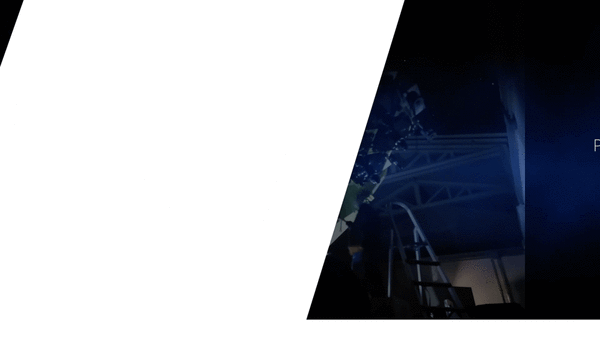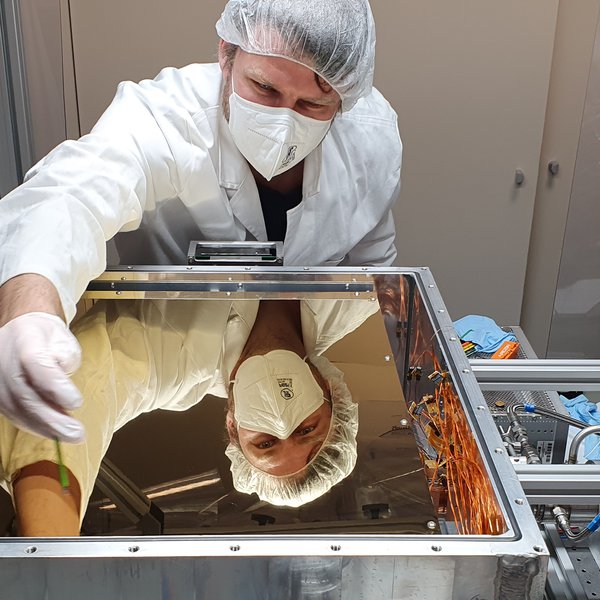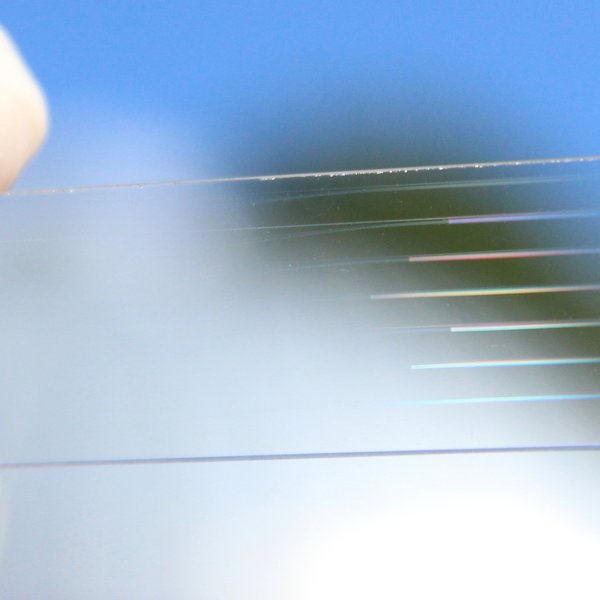Astrophotonics (innoFSPEC)

For next generation ground- and space-based astronomy, we are developing "Star-light processors", with both active and passive photonic components, with collaborators and partners from industries, foundries, astronomical observatories, and universities.
innoFSPEC means "Innovative faseroptische Spektroskopie und Sensorik". From molecules to galaxies - innoFSPEC is a research and innovation centre pursuing multidisciplinary research in the field of optical fibre spectroscopy and sensing. The centre was created as a joint venture of the Leibniz Institute for Astrophysics Potsdam (AIP) and the Physical Chemistry group of the University of Potsdam (UP).
Ongoing Projects
E-MARCOT

MARCOT Pathfinder is a multiple array of combined telescopes that can be easily expanded and/or replicated at very low costs.
MARCOT Pathfinder is a new European "segmented telescope" concept with a large effective aperture built at a very low cost, and is being developed by CAHA and supported by innoFSPEC-Astrophotonics at AIP.
Contact : MARCOT
Consortium : CAHA, Instituto de Astrofisica de Andalucia, innoFSPEC
Website : MARCOT Consortium
[more]POCO
Potsdam frequency comb, POCO, (Spanish for "little bit") is a turn-key instrument designed and developed by innoFSPEC that uses specially designed micro-ring resonators to generate ultra-stable comb lines for calibration of astronomical spectrographs. POCO comes in a 19" rack format and is easily transportable. It is currently being modified to function in remote-operation mode for STELLA-SES.
POCO currently as a stability of < 1 m/s (radial velocity). With astrophotonic components, the elusive 10 cm/s stability is tantalizingly within reach.
Contact : Daniel Bodenmüller, Kalaga Madhav
Collaborators : Georg-August-Universität
PAWS

PAWS during integration with the cryogenically cooled infrared array Teledyne H2RG in the innoFSPEC laboratory. The gold-coated top radiation shield can be seen. PAWS provides a spectral resolution of R-15,000 in the astronomical H-band with unprecedented efficiency. Innovative spectrographs of this kind for future space missions promise significant savings in mass and volume compared to, for example, the 196 kg NIRSpec on board the James Webb Space Telescope.
Potsdam Arrayed Waveguide Spectrograph (PAWS) is first of its kind instrument that utilises a compact AWG component specially designed for photon-starved NIR astronomy. PAWS currently in the assembly and integration phase. Cooperation with established foundry has yielded a device with the state-of-the-art performance: high spectral resolution, high throughput, broad free spectral range, high polarization immunity and high temperature stability. Other key components such as OH-emission filter elements can be integrated on the same chip.The concept “astronomy-on-chip” may spark a paradigm shift in the astronomical instrumentation as the light-weight PLC-based devices can provide simultaneously superior functionalities and greater robustness. A packaged module further allows efficient thermal management and shielding against external disturbances.
PAWS can be calibrated using POCO.
PAWS is a first step towards space applications.
Contact : Kalaga Madhav, Eloy Hernandes
OH-SUPER
A serious problem for ground-based NIR astronomy consists in the presence of a large number of strong hydroxyl (OH) emission lines originating in the earth’s atmosphere. This emission starts at around 610 nm and covers almost the whole NIR up to 2.62 µm, as a result of which in this wavelength range, spectroscopy from the ground is strongly compromised. The maximum intensity of the OH emission lies around 1500 nm. The intensity is several orders of magnitude larger than the extraterrestrial background of faint stars or galaxies and thus it contributes substantially to the stray light signals inside the spectrograph, making the measurement of the faint extraterrestrial signals very challenging. An additional issue are the rapid intensity fluctuations of the OH emission, which makes the subtraction of reference spectra very difficult or even impossible.
The superb sensitivity of the ELT (and other large ground-based telescopes) is severely hampered by strong atmospheric OH emission lines, rendering the huge capital investment for the next generation of large telescopes almost useless for low to medium resolution spectroscopy in the NIR. This problem is particularly acute for instruments like ELT-MOS/MOSAIC.
OH suppression spectrographs built with special masks and additional optical components create excess stray light within the optical system, thus counter-acting the intended filter effect. FBGs offer excellent properties to filter out the OH emission lines. However, using an array of simple FBGs will result in high losses. An extension to simple FBGs are aperiodic FBGs (AFBGs). A single AFBG can provide as many as 100 notches to filter out the NIR OH emission lines.
AFBG OH-emission filters can fabricated using three different methods :
- Complex Phase Masks (CPM) : At innoFSPEC-Astrophotonics, world's first CPMs for astronomy have been fabricated in collaboration with Friedrich Schiller University and Fraunhofer IOF, Jena.
- Line-by-line inscription using an Ultrafast femtosecond laser : A fully-automated ULI system that can fabricate complex structures in glass substrates or fibres has been custom developed for innoFSPEC-Astrophotonics.
- Advanced "running light" Modified Elliptical Talbot Interferometer (METI) : For flexibly of fabrication, the METI fabrication facility, a unique one-of-its-kind facility supported through the BMBF Strategic Investment, has been developed. METI incorporates custom built large-range translation stages, where all the 6-axes are stabilised using a closed-loop laser interferometer and computer-fibre link system, for ambient temperature, pressure, and vibration.
Collaborators : IAP, Friedrich Schiller University, Jena, Fraunhofer IOF, Jena
Partners : University of Sydney, Macquarie University
Contact : Aashia Rahman, Kalaga Madhav
PI : Aashia Rahman
Telescope Beam Combiners
Nobel Prize in Physics 2020 heralds a new era of astronomy using Astrophotonic components. At the heart of ESO GRAVITY instrument lies a 2D integrated optics device that combines light from 4 telescopes in K-band. The 3D discrete beam combiners (DBC), designed and developed at innoFSPEC Astrophotonics group, have no complexity, and have the simplest geometry of all other types of beam combiners. The DBC allows a straightforward scaling to larger arrays of telescopes by simply extending the number of waveguides in the array.
With the new state-of-the-art fully automated ultrafast laser inscription facility of Astrophotonics group, complex 3D waveguide structures can be inscribed in glass.
First generation H-band 3D beam combiners, fabricated in collaboration with Politecnico di Milano, have been successfully tested on-sky in 2018, at the William Herschel Telescope in La Palma, Spain.
A K-band beam combiner developed in collaboration with Herriot Watt University, University of Köln was tested on-sky test at the CHARA Array in July 2022 and November 2022. Follow up on-sky experiments were conducted in 2023 and 2024.
The CHARA Array Integrated Optics Testbench (CHARIOT) was installed on the mountain in 2023 and first light was achieve on 2nd May 2024 with world's first K-band beam combiner fabricated using the Ultrafast laser inscription (ULI) process using the CHARIOT
Collaboration : Herriot-Watt University, Physikalisches Institut Uni Köln
Contact : Aline Dinkelakar, Kalaga Madhav
Adaptive Optics for Astrophotonics

Efficiently coupling star light into the single-mode photonic components is hindered by the presence of atmospheric turbulence. A LOAO (SC) system has been developed that uses the traditional approach of AO correction along with few-mode photonic lanterns (PLs).
Atmospheric turbulence is the main limiting factor for the achievement of high-resolution images with single aperture, ground based telescopes. Local, small-scale (from centimeters to meters) variations of the air density are corrupting of the spatial coherence of light arriving from the stars. As a consequence, a telescope can focus the light on a spot which is usually several times larger (up to ~100 times with extremely large telescopes) than the theoretical focusing capability of the telescope itself (diffraction limit). This effect limits the widespread use of compact astronomical instrumentation based on integrated optics components, which require light with high spatial coherence to couple efficiently into single-mode waveguides. Two possible approaches have been identified so far to improve the coupling efficiency of starlight into integrated optics components.
The most direct approach consists in actively correcting for the distortion of the spatial coherence of starlight. This is already possible thanks to adaptive optics, a technique using a deformable mirror to correct distortions in real time and focus the starlight town to the diffraction limit. This approach is however a very expensive and complex one, especially for very large telescopes. A photonic solution to this problem is use a photonic lantern to distribute the light collected by a multimode fiber placed at the focus of the telescope into several single-mode fibers outputs.
Contact : Kalaga Madhav
Photonic Lanterns

A 19-fibre photonic lantern (PL) fed by SCAO-corrected input can be assembled into a standard optical fibre FC connector to form a diffraction-limited slit that can reduce the size of astronomical spectrographs. The single-mode outputs can also be used to introduce fibre Bragg grating (FBG) based OH-emission filters before feeding the star light into spectrographs.
Photonic lanterns (PL) are photonic (or fibre optic) devices that distribute the light collected by a large multimode waveguide (or optical fibre) into multiple near diffraction-limited waveguides (or single-mode fibres). In astrophotonics, such devices are crucial to couple star light efficiently from a telescope into photonic components.
Partners : University of Bath
Contact : Kalaga Madhav, Aline Dinkelakar


